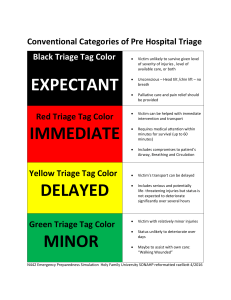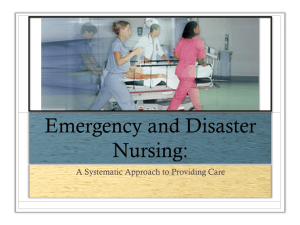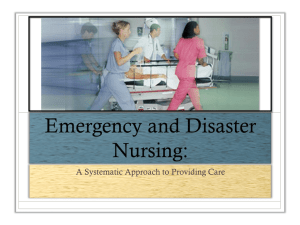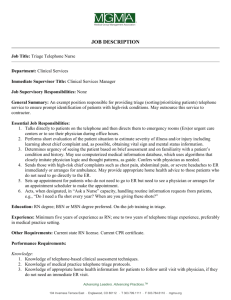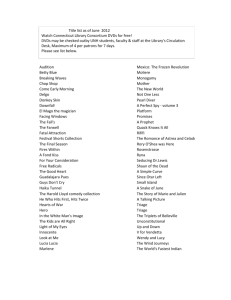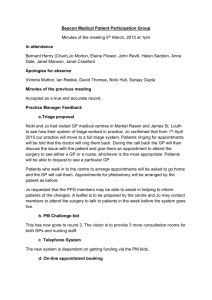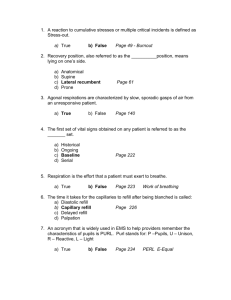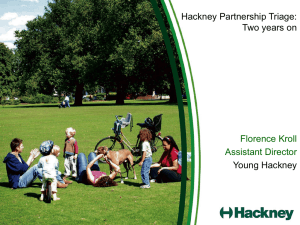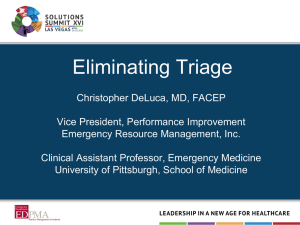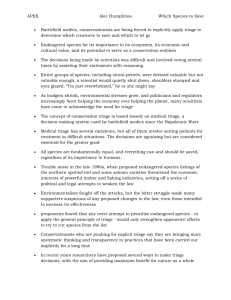Chapter 1b SALT Triage
advertisement
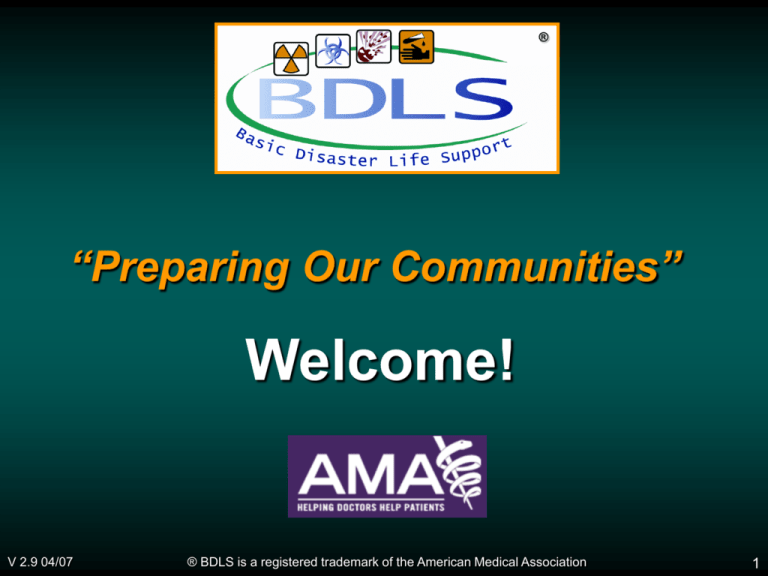
® “Preparing Our Communities” Welcome! V 2.9 04/07 ® BDLS is a registered trademark of the American Medical Association 1 Faculty Disclosure • For Continuing Medical Education (CME) purposes as required by the American Medical Association (AMA) and other continuing education credit authorizing organizations: – In order to assure the highest quality of CME programming, the AMA requires that faculty disclose any information relating to a conflict of interest or potential conflict of interest prior to the start of an educational activity. – The teaching faculty for the BDLS course offered today have no relationships / affiliations relating to a possible conflict of interest to disclose. Nor will there be any discussion of off label usage during this course. V 2.9 04/07 2 ® Chapter 1b SALT Triage (Sort, Assess, Life-Saving, Treatment/Transport Triage) V 2.9 04/07 ® BDLS is a registered trademark of the American Medical Association 3 Objectives • Describe the S.A.L.T. Triage method • Describe the steps to perform S.A.L.T Triage • Describe the Life Saving Interventions that are performed in in S.A.L.T. Triage • List the Triage Categories as defined in S.A.L.T. Triage. • Describe injuries that would place a patient in each triage category V 2.9 04/07 4 What is Triage? • French verb “trier” = to sort • Assign priorities when resources limited • Do the greatest good for the greatest number V 2.9 04/07 Source: DoD Photo Library, Public Domain 5 What’s Unique About Disaster Triage? • Number of patients • Infrastructure limitations – – – – Limited providers Limited equipment Limited transport capabilities Hospital resources overwhelmed • Scene hazards – Threats to providers – Decontamination issues • Multiple agencies responding V 2.9 04/07 6 SALT Triage • Simple • Easy to remember • Groups large numbers of patients together quickly • Applies rapid life-saving interventions early V 2.9 04/07 7 STEP 1: Global Sorting • Priority 1: Still/Obvious life threat • Priority 2: Wave/Purposeful movement • Priority 3: Walk V 2.9 04/07 9 Global Sorting: Action 1 • Action: – “Everyone who can hear me and needs help, move to [designated area]” • Use loud speaker if available • Goal: – Group ambulatory patients using voice commands • Result: – Those who follow this command - last priority for individual assessment V 2.9 04/07 10 Global Sorting: Action 2 • Action: – “If you need help, wave your arm or move your leg and we will be there to help you in a few minutes” • Goal: – Identify non-ambulatory patients who can follow commands or make purposeful movements • Result: – Those who follow this command - second priority for individual assessment V 2.9 04/07 11 Global Sorting Result • Casualties are now prioritized for individual assessment – Priority 1: Still, and those with obvious hemorrhage – Priority 2: Waving – Priority 3: Walking V 2.9 04/07 12 Step 2: Individual Assessment • Provide Life Saving Interventions – Controlling major hemorrhage – Opening airway if not breathing • If child, consider giving 2 rescue breaths – Chest needle decompression – Auto injector antidotes V 2.9 04/07 13 S.A.L.T. Triage Categories • Immediate • Delayed • Minimal • Expectant • Dead V 2.9 04/07 14 Immediate • Serious injuries • Immediately life threatening problems • High potential for survival. • Examples Photo Source: www.swsahs.nsw.gov.au Public Domain V 2.9 04/07 – Tension pneumothorax – Nerve agent exposed patient • severe shortness of breath or seizures 15 Delayed • Serious injuries – require care but management can be delayed without increasing morbidity or mortality. V 2.9 04/07 Photo Source: Phillip L. Coule, MD • Examples – Long bone fractures • neuro-vascular intact • 40% BSA exposure to Mustard 16 Minimal • Injuries- require minor care or no care without adverse affect. • Examples – Abrasions – Minor lacerations – Nerve agent exposure with mild rhinorrhea Photo source: Phillip L. Coule, MD V 2.9 04/07 17 Expectant • Important for preservation of resources • DOES NOT MEAN DEAD! • Should receive comfort care or resuscitation when resources are available • Serious injuries – very poor survivability even with maximal care in the hospital or pre-hospital setting. • Examples – 90% BSA burn – Multiple trauma with exposed brain matter – Severe traumatic brain injury with herniation V 2.9 04/07 18 Dead Patients • Tag dead patients to prevent re-triage • Do not move – Except to obtain access to live patients – Avoid destruction of evidence V 2.9 04/07 19 After Patients are Categorized • Prioritization process is dynamic – Changing patient conditions – Changing resources – Scene safety. • After immediate patients have been cared for – Expectant, delayed, or minimal patients should be re-assessed – Some patients will have improved and others will have decompensated V 2.9 04/07 21 Treatment/Transport Priority • Treatment and/or transport should be provided for immediate patients first – Then delayed – Then minimal • Expectant patients should be provided with treatment and/or transport when resources permit • Efficient use of transport assets may include mixing categories of patients and using alternate forms of transport V 2.9 04/07 22 Patient #1 • 63 y/o male, prone, unresponsive • Burns on extremities • Did not move at “walk/wave” phase V 2.9 04/07 23 Patient #2 • 42 y/o female • Walks to safety when instructed • No bleeding, normal pulses, normal breathing V 2.9 04/07 24 Patient #3 • • • • 17 y/o male, lying supine, waving for help Breathing well, follows commands Normal vital signs Can’t get up due to back pain and leg weakness V 2.9 04/07 25 Patient #4 • 26 y/o male, unresponsive • Contusions on head • Good pulses, HR 104, RR 12 V 2.9 04/07 26 Patient #5 • 52 y/o female, unresponsive • Breathes when airway opened – needs to have airway maintained manually • Bleeding heavily from abdominal injury • RR 8, HR 124 V 2.9 04/07 27 Questions? V 2.9 04/07 28
